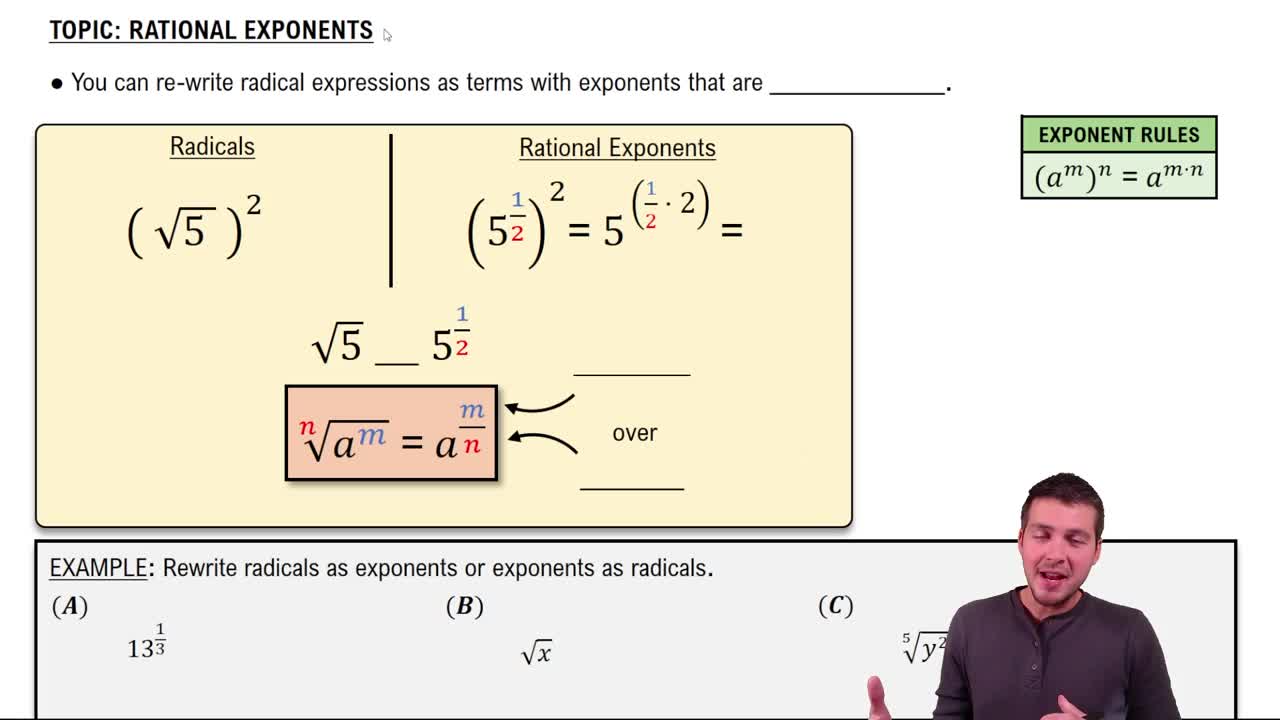Table of contents
- 0. Review of Algebra4h 16m
- 1. Equations & Inequalities3h 18m
- 2. Graphs of Equations43m
- 3. Functions2h 17m
- 4. Polynomial Functions1h 44m
- 5. Rational Functions1h 23m
- 6. Exponential & Logarithmic Functions2h 28m
- 7. Systems of Equations & Matrices4h 6m
- 8. Conic Sections2h 23m
- 9. Sequences, Series, & Induction1h 19m
- 10. Combinatorics & Probability1h 45m
0. Review of Algebra
Exponents
Problem 83e
Textbook Question
In Exercises 83–90, evaluate each expression without using a calculator. 36^(1/2)
 Verified step by step guidance
Verified step by step guidance1
Recognize that the expression \(36^{1/2}\) is asking for the square root of 36.
Recall that the square root of a number \(x\) is a value \(y\) such that \(y^2 = x\).
Identify the number whose square is 36. In this case, think of numbers that multiply by themselves to give 36.
Consider the positive and negative roots, but focus on the principal (positive) square root for this exercise.
Conclude that the principal square root of 36 is the number that, when squared, equals 36.
Recommended similar problem, with video answer:
 Verified Solution
Verified SolutionThis video solution was recommended by our tutors as helpful for the problem above
Video duration:
59sPlay a video:
Was this helpful?
Key Concepts
Here are the essential concepts you must grasp in order to answer the question correctly.
Exponents
Exponents are a mathematical notation indicating the number of times a number, known as the base, is multiplied by itself. In the expression 36^(1/2), the exponent 1/2 signifies the square root of the base, which is 36. Understanding exponents is crucial for simplifying expressions and performing operations involving powers and roots.
Recommended video:
Guided course

Rational Exponents
Square Roots
The square root of a number is a value that, when multiplied by itself, gives the original number. For example, the square root of 36 is 6, since 6 * 6 = 36. Recognizing how to compute square roots is essential for evaluating expressions involving fractional exponents, particularly those with a denominator of 2.
Recommended video:

Imaginary Roots with the Square Root Property
Radical Notation
Radical notation is a way to express roots using the radical symbol (√). The expression 36^(1/2) can also be written as √36. Understanding radical notation helps in recognizing and simplifying expressions involving roots, making it easier to evaluate them without a calculator.
Recommended video:
Guided course

Expanding Radicals

 7:39m
7:39mWatch next
Master Introduction to Exponent Rules with a bite sized video explanation from Patrick Ford
Start learningRelated Videos
Related Practice













